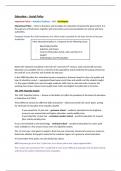Education – Social Policy
Important Points – Statistics/Evidence – A03 - Sociologists
Educational Policy – refers to the plans and strategies for education introduced by government. E.G.
through Acts of Parliament, together with instructions and recommendations to schools and local
authorities.
Examples include the 2010 Academies Act, which made it possible for all state schools to become
academies.
Most educational policy is a response to the following issues:
- Equal Opportunities
- Selection and Choice
- Control of Education (what, when and how it is
taught)
- Marketisation and Privatisation
Before the industrial revolution in the late 18 th and early 19th century, state schools did not exist.
Education was available only to a minority of the population and provided by fee-paying schools for
the well off, or by churches and charities for the poor.
In the 1880 Education Act, education became compulsory, however based on class, the quality and
type of education varied -> segregated based upon social class and wealth and the subjects taught,
i.e. the upper/middle class may be taught academic skills, how to read and write, however the
working-class (lower classes) were taught basic maths and English to enable jobs in factories.
The 1944 Tripartite System
The 1944 Tripartite System -> Known as the Butler Act (after the president of the board of education
or Education Act (1944).
Three different schools for different skills and talents – sifted and sorted into career paths, aiming
for each type of education to be equally valuable.
- If you passed the 11 plus test – grammar school – academic education for the brightest,
access to non-manual jobs and higher education, mainly middle-class
- If you failed the 11 plus test – secondary modern school – practical education for manual
jobs, mainly working-class
If you were talented in arts/technology – technical school – vocational education for career path
(only available in a few areas), hence more of a bipartite system.
The 11+ test was a test given to pupils in their last year of primary school and is used as a means to
determine whether that pupil is suited to the academic rigours of a grammar school education.
A Conservative Party policy, but also backed by Labour.
A03: Everyone got to sit the 11 plus test, so in theory there was ‘equal opportunities’.
The 11 plus test was biased, W/C would find it much more difficult to pass/get into the best schools,
and hence the system reproduced class inequality.
, The amount of marks needed to pass was higher for girls than boys.
Tripartite system reproduced class inequality – creating two social classes, two different schools and
futures.
Is it meritocratic? -> Contacts of parents, tutors ££, Traditional families, Cultural Capital.
Learning difficulties, mental health issues -> ASD/ADD/ADHD would not have apt provision and thus
even if naturally talented but may not be able to pass the single test.
Only tested in maths and English -> does not account for talents in other academic fields (i.e.
Sciences).
Feminists would criticise this policy as you would have to have gotten higher marks to get through.
The Comprehensive System (labour party) (HAROLD WILSON)
Was introduced in many areas from 1965 onwards, it aimed to overcome the class divide of the
tripartite system and make education more meritocratic.
The 11+ was to be abolished along with grammars and secondary moderns, to be replaced by
comprehensive schools that all pupils within the area could attend.
Everyone theoretically should go to comprehensive schools and meant education for everyone in
one place, meaning that the M/C were not ‘cream-skimmed’ by grammar schools (reducing class
inequality as there would be a social mixing of the classes).
Arguably it should be beneficially for those who were less ‘academic’ as they could be helped by
others and motivated by it, as educated within the same school.
A03: It was left to the local education authority to decide whether to ‘go comprehensive’ and not all
did so – and hence the grammar-secondary modern divide still existed in many areas.
Sociological theory of the role of comprehensive schools
Marxism Functionalism
See the role of education as serving the interests of See the role of education as fulfilling essential functions
capitalism by reproducing and legitimising class inequality such as social integration and meritocratic section for
future work roles.
Marxists argue that comprehensives are not meritocratic,
and they reproduce class inequality from one generation Functionalists argue that comprehensives promote social
to the next through the continuation of the practice of integration by bringing children of different social classes
streaming and labelling. These continue to deny the w/c together in one school.
children equal opportunity. However, Ford (1969) found little social mixing between
working-class and middle-class pupils, largely because of
By not judging ability at 11, they argue comprehensives streaming.
may appear to offer equal chances to all, this ‘myth of Functionalists also see the comprehensive system as
meritocracy’ legitimates and justifies class inequality by more meritocratic as it gives pupils a longer period in
making underachievement seem fair and just, making which to develop and show their abilities, unlike the
failure look like it is the fault of the individual, rather than tripartite system which sought to select the most able
the system. pupils at the age of 11.




